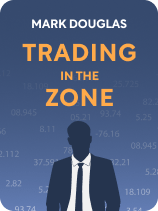

This article is an excerpt from the Shortform book guide to "Trading in the Zone" by Mark Douglas. Shortform has the world's best summaries and analyses of books you should be reading.
Like this article? Sign up for a free trial here .
Do you struggle to stick to your trading rules because emotions get in the way? Are you haphazardly buying and selling without a trading plan in place?
Trading your hard-earned money is an emotional rollercoaster. Therefore, it’s important to exercise self-discipline and keep your emotions at bay. According to author and trading consultant Mark Douglas, this requires that you simultaneously do two things: redirect negative thoughts and emotions, and execute the system you’ve established.
Here’s how to develop discipline in trading, according to Douglas.
Monitor and Redirect Negative Thoughts
The first part of exercising self-discipline in trading involves closely monitoring your thoughts and emotions. Douglas claims the process of becoming a consistently successful trader is psychological, so you must stay alert to any thought that causes you to doubt your system, yourself, or the market. As we’ve discussed, any time fear surfaces, you become vulnerable to making errors. Therefore, if you detect any fear or negative thoughts, gently redirect your thoughts to the core beliefs that all successful traders internalize, which we’ve already covered:
- Eliminating risk is impossible.
- Each market outcome is unique and random.
- You can never know or control what will happen next.
- You can make money regardless of individual outcomes.
- When you have an edge, every loss brings you closer to a win.
According to Douglas, by routinely redirecting negative thoughts, you can create the mental conditions that allow you to enter the zone. Then, you’ll see market activity as just neutral information, telling you what the odds are for success or failure. In other words, you’ll view the market from a truly objective perspective, seeing it not as a threat but as a source of unlimited opportunities to win and profit. As a result, Douglas says, you won’t be inclined to distort or deny information based on what you’re afraid will happen. Instead, you’ll act without hesitation even in the face of constant uncertainty—with the appropriate amount of restraint.
| Research on How to Control Negative Thoughts Douglas suggests you can—and should—willfully redirect negative thoughts, but research suggests this might not be so easy. Psychologists agree with Douglas that persistent negativity can be harmful and can prevent you from entering the zone and viewing events objectively. However, they say that glossing over these negative thoughts and feelings with positive thinking is only a temporary fix. Positive affirmations operate at the surface level of conscious thinking, leaving negative thoughts rooted at the subconscious level undisturbed. This means that ultimately, you’d still risk falling short of the calm, objective, restrained mindset that Douglas recommends. If positive affirmations aren’t enough to tackle your negative mindset, here are some steps you can take to empower yourself to think more positively and achieve the mindset Douglas says is essential to be a winning trader: – Have designated “negative thought time.” Commit 10 minutes every day to stewing on negative thoughts. When you know you’ve got time set aside to review lingering fears and concerns, you’re less likely to let them dominate the rest of your day. – Write down your negative thoughts. Writing helps purge negative thoughts so you have more mental space to move forward and think positively. – Consider what you’d say to your best friend. If your friend were experiencing the same negative thoughts and feelings, what would you say to them? This technique can help you see things more objectively. – Ask yourself some questions. Research shows that asking ourselves questions rather than issuing commands is a more effective way to create change because it triggers the problem-solving areas of the brain. For instance, ask yourself, “What’s a different way to think about this?” |
Execute Over Time
The second part of exercising self-discipline in trading involves perfectly implementing the system you’ve established, resisting any temptation to make adjustments. According to Douglas, by staying disciplined in your thoughts and actions, you’ll accumulate positive experiences that align with your objectives and the beliefs you want, thereby reducing interference from fear, doubt, and negative interpretations of your experiences. Then, you’ll see the market objectively, perceive opportunities clearly, and achieve consistent success. All internal resistance will be gone.
(Shortform note: Can positive experiences offset negative experiences, as Douglas says? Researchers say yes: Studies show that it takes three positive experiences to offset one negative experience. Why do we need more positive experiences to outweigh the effect of a single negative experience? Our brains have a built-in negativity bias that causes us to perceive or overinflate negativity, even when a situation is positive or neutral, and dwell on negative events more than positive ones.)
Thus, if you incur a trading loss, Douglas says your best course of action is to continue trading according to the rules you’ve established in your system (assuming your system is sound). As market activity unfolds, you’re sure to win over the long term due to the probabilistic nature of the market.
Given the dynamic nature of the market, Douglas notes, you’ll likely need to adjust your trading variables and rules at some point. Any edge you define is based only on a single moment in time. As market activity unfolds—and traders come and go—the effectiveness of your system may decline. However, you need to give your current system a chance to work. Remember: You need a large enough sample size for probabilities to play out in your favor.
How many trades are enough to test your variables? Douglas recommends a sample size of at least 20 trades. Then, if needed, you should make adjustments and complete your next 20 trades using the new set of variables. By trading in sample sizes, you’ll be able to accommodate changes while maintaining a steady approach.
| Some Investment Experts Dispute Douglas’s Advice Many investment experts dispute Douglas’s assertion that a sample size of 20 trades—or even 100 trades—is sufficient to judge whether or not a trading strategy works. Instead, they recommend automated trading, which allows you to execute and assess the profitability of 1000 trades or more in a short time frame. A high trading volume and short turnaround time allow you to quickly determine if you have an edge and make adjustments as needed. Other experts advise against making individual investments on your own altogether. Given the random, unpredictable nature of the market, they say it’s unlikely you have an edge—no matter which analysis strategy you use. Instead, they recommend that you put your money in a passively managed index fund, which doesn’t require you to actively manage your investments. Investments are chosen automatically to match an index with the intention to keep pace with market returns by mirroring certain market segments. Ultimately, though, there’s no consensus among financial experts about which investment strategy is best, so be sure to choose carefully when you’re deciding how to invest your money. |

———End of Preview———
Like what you just read? Read the rest of the world's best book summary and analysis of Mark Douglas's "Trading in the Zone" at Shortform .
Here's what you'll find in our full Trading in the Zone summary :
- The role mindset plays in stock trading
- The critical importance of embracing risk
- How to become a confident, consistent winner






